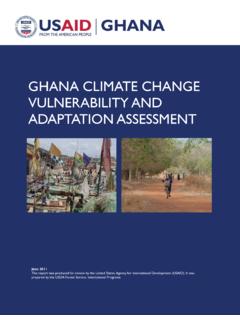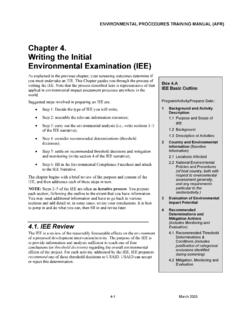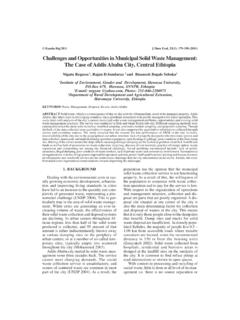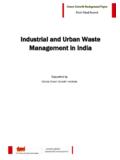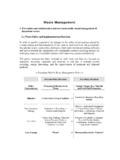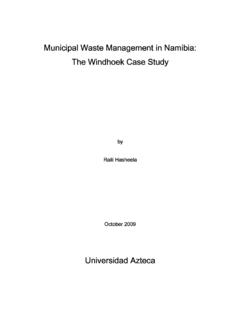Transcription of Chapter 15 Solid waste: generation, handling, …
1 Version: March 2009 Learn more about the Environmental Guidelines for Small-Scale Activities in Africa and download this and all chapters at This EGSSAA Chapter was prepared by The Cadmus Group, Inc. for International Resources Group, Ltd. Environmental Guidelines for Small-Scale Activities in Africa (EGSSAA) (IRG) under USAID Africa Bureau s Environmental Compliance and management Support (ENCAP) Program, Contract Number EPP-I-00-03-00013-00, Task Order No. 11. Its contents are the sole responsibility of the authors and do not necessarily reflect the views of USAID or the United States Government.
2 Chapter 15 Solid waste : generation , handling , treatment and disposal The adverse impacts of waste management are best addressed by establishing integrated programs where all types of waste and all facets of the waste management process are considered together. The long-term goal should be to develop an integrated waste management system and build the technical, financial, and administrative capacity to manage and sustain it. Contents Brief Description of the Sector 1 Potential Environmental Impacts 3 Sector Design 5 Environmental Mitigation and Monitoring 16 Resources and References 26 Brief Description of the Sector Thousands of tons of Solid waste are generated daily in Africa.
3 Most of it ends up in open dumps and wetlands, contaminating surface and ground water and posing major health hazards. generation rates, available only for select cities and regions, are approximately kilograms per person per day in some cases reaching as high as kilograms per person per day. While this may seem modest compared to the1 2 kg per person per day generated in developed countries, most waste in Africa is not collected by municipal collection systems because of poor management , fiscal irresponsibility or malfeasance, equipment failure, or inadequate waste management budgets.
4 For more These guidelines are intended to be a starting point for developers and managers of Solid waste projects. They are designed to highlight key issues, questions to consider, and technical options. More detailed resources are cited at the end of this document. Solid waste project developers and managers should pay particular attention to The International Source Book on Environmentally Sound Technologies for Municipal Solid waste management , produced by the International Environmental Technology Centre of the United Nations Environment Programme.
5 Though high- and low-value recyclables are typically recovered and reused, these make up only a small proportion of the total waste stream. The great majority of the waste (~70 percent) is organic. In theory, this waste could be converted to compost or used to generate biogas, but in situations where rudimentary Solid waste management systems barely function, it is difficult to promote innovation, even when it is potentially cost-effective to do so. In addition, hazardous and infectious materials are discarded along with general waste throughout the continent.
6 This is an especially dangerous condition that complicates the waste management problem. Throughout most of sub-Saharan Africa Solid waste generation exceeds collection capacity. This is in part due to rapid urban population growth: while only 35 percent of the sub-Saharan population lives in urban areas, the urban population grew by 150 percent between 1970 and 1990. But the problem of growing demand is compounded by broken-down collection trucks and poor program management and design. In West African cities, as many as 70 percent of trucks are always out of service at any one time, and in 1999 the City of Harare failed to collect refuse from nearly all of its residents because only 7 of its 90 trucks were operational.
7 For health reasons, waste in tropical regions should actually be collected daily. This makes the challenges and costs of Solid waste management in much of Africa even more daunting. It is generally the city center and the wealthier neighborhoods that receive service when it is available. In poorer areas, uncollected wastes accumulate at roadsides, are burned by residents, or are disposed of in illegal dumps which blight neighborhoods and harm public health. Where present, manual street sweeping by municipal employees or shopkeepers may help reduce these effects in the most public areas.
8 Nonetheless, roadside accumulation in many cities has reached levels resembling those that spawned epidemics in European cities 500 years ago. Unless more effective urban waste management programs and public water supply systems are put in place, outbreaks of cholera, typhoid and plague may become increasingly common. Recommended Frequency of waste Collection Tropics Daily Temperate regions Summer Every 2 days Winter Every 3 days Cool climates Summer Twice a week Winter Once a week Only a small amount of the region s waste is disposed of in sanitary landfills; most is deposited in open dumps or semi-controlled unlined landfills with no groundwater protection, leachate recovery, or treatment systems.
9 The larger dumps are located on the edges of cities, towns, and villages, sometimes in ecologically sensitive areas, or areas where groundwater supplies are threatened. They serve as breeding grounds for rats, flies, birds and other organisms that serve as disease vectors. Smoke from burning refuse may be damaging to the health of nearby residents and the smell degrades their quality of life. While the recovery and reuse of materials is generally for personal use, there are also many professional waste pickers. They are seriously threatened by disease organisms, sharp objects and other hazards in the waste , especially since they generally lack protective equipment.
10 The high level of reuse of non-organic waste reflects the extent of poverty in the region. Separation and treatment of organic waste is very rare. Municipal composting programs exist in some South African cities, but the few large-scale composting facilities built elsewhere are no longer operating. Anaerobic digestion to produce methane is not widely applied, and then usually uses manure, not organic waste . While Solid waste collection is generally a municipal function, some countries and municipalities are now experimenting with limited privatization of these services, with some success.
